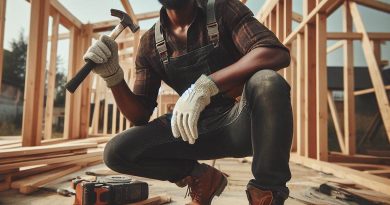Building Codes and Standards: Carpenter’s Compliance Guide
Last Updated on November 6, 2023
Introduction
Carpenter Building codes and standards refer to regulations and guidelines that ensure safe and
quality construction practices.
Compliance with building codes and standards is crucial for carpenters as it guarantees
the structural integrity and safety of buildings.
This blog post aims to provide carpenters with a comprehensive guide to understanding and
adhering to building codes and standards.
Overview of Building Codes and Standards
Explanation of building codes
- Building codes are regulations that set minimum standards for construction and safety.
- These codes have evolved over time to ensure the safety and well-being of occupants.
- Government and industry organizations are responsible for creating and maintaining building codes.
Understanding standards
- Standards are guidelines that help ensure safety and quality in construction projects.
- They play a crucial role in improving the built environment and protecting public welfare.
- There are different types of standards, including construction, fire safety, and structural standards.
The relationship between codes and standards
- Building codes often reference specific standards that must be followed for compliance.
- Harmonization efforts aim to align codes and standards to avoid conflicting requirements and promote consistency.
Building codes, set by authorities, guarantee construction safety. They have evolved with incidents and technology advancements. Carpenters follow these codes, ensuring secure structures.
Government agencies and industry bodies create and enforce codes, covering structural integrity, fire safety, accessibility, electrical, and plumbing.
Standards, from professional organizations, offer criteria for materials and installations, maintaining quality and safety. Carpenters must follow codes and standards.
The link between building codes and standards is vital.
Codes reference standards for compliance, covering materials, design, installation, and testing.
Carpenters adhering to standards ensure product safety and quality.
Compliance reduces defects, lowers liability, and enhances the built environment.
Harmonization aligns codes and standards, reducing conflicts and aiding compliance across regions. Carpenters benefit from consistent requirements.
Construction standards cover materials, design, installation, and safety. Fire standards prevent fires through materials and suppression systems. Structural standards ensure stability.
Carpenters need code and standard knowledge for safe, quality projects. Staying updated on changes is crucial for professionalism.
In essence, building codes and standards guide carpenters to secure and high-quality construction, ensuring compliance and professionalism.
Read: Specialized Niches: Exploring Unique Carpentry Fields
Carpenter’s Compliance Guide to Building Codes and Standards
Role of carpenters in ensuring compliance
- Building code interpretation and application
- Knowledge of specific standards relevant to carpentry
Common areas where carpenters need to comply
- Structural requirements
- Fire safety regulations
- Accessibility standards
- Materials and fastening specifications
Tools and resources for carpenters
- Building code and standard manuals
- Training programs and certifications
- Collaborating with architects and engineers
Read: How to Launch Your Carpentry Business in the USA
Challenges and Solutions
Building codes and standards play a vital role in the construction industry, ensuring the safety, durability, and sustainability of structures.
As a carpenter, compliance with these codes and standards is essential to maintain the quality of your work and ensure the safety of occupants.
However, there are several challenges you may face when it comes to understanding and adhering to these regulations.
Complexity of codes and standards
The language and terminology used in codes and standards can be complex and difficult to comprehend.
Carpenters often need to decipher technical jargon and grasp the specific requirements outlined in the documents.
Understanding these complex codes and standards is a critical step in ensuring compliance and delivering high-quality work.
Another challenge is the frequent updates and revisions made to codes and standards.
As new technologies emerge and building practices evolve, regulations are constantly being revised to reflect these changes.
It can be challenging for carpenters to keep up with these updates, which may require learning new techniques, materials, or construction methods.
Strategies for staying updated
To overcome the challenges posed by the complexity and frequent updates of codes and standards, carpenters can adopt certain strategies.
Subscribing to relevant publications and newsletters can provide a consistent stream of information on changes in regulations.
These resources often explain the updates in a more accessible language, making it easier for carpenters to understand and implement them in their work.
Participating in industry conferences and seminars is another effective way to stay updated on codes and standards.
These events gather industry experts who share their knowledge and provide insight into the latest regulations.
By attending such conferences and seminars, carpenters can learn about upcoming changes, gain valuable insights, and network with other professionals in the field.
Joining professional associations and online forums also proves beneficial for carpenters seeking to stay informed.
These platforms offer opportunities to connect with colleagues and industry experts, exchange information, and discuss challenges faced in complying with codes and standards.
Being a part of these communities fosters a continuous learning process and ensures carpenters stay up to date with the latest practices and requirements.
Collaborating with other trades and professionals
Collaboration with other trades and professionals is essential for successfully implementing codes and standards.
Effective communication and coordination among different stakeholders ensure that all aspects of a project meet the required standards.
Carpenters must actively engage with architects, engineers, and other trades to align their work with the overall project goals and regulations.
In joint projects involving multiple trades, compliance with codes and standards becomes even more critical.
Carpenters must ensure that their work integrates seamlessly with the work of others, guaranteeing overall compliance.
Regular communication with other trades helps create a shared understanding of the requirements, enabling better coordination and synchronization.
In fact, carpenters face challenges posed by the complexity and constant updates of building codes and standards.
To overcome these challenges, staying updated through publications, conferences, and professional associations is crucial.
Collaborating with other trades and professionals ensures compliance and the successful completion of projects.
By acknowledging these challenges and implementing appropriate strategies, carpenters can maintain compliance and ensure the quality and safety of their work.
Read: Carpentry Certifications: Boosting Your Career in the US

Benefits of Compliance for Carpenters
Ensuring Safety and Quality of Finished Projects
- Compliance with building codes ensures the safety of both the carpenters and the occupants.
- Following standards guarantees that the final product meets high-quality standards.
- By adhering to regulations, carpenters can minimize the risk of accidents and structural failures.
- Building codes provide guidelines for proper materials and construction techniques, resulting in sturdy and durable finished projects.
- Complying with safety requirements reduces the chances of legal liability for carpenters.
Avoiding Potential Legal Issues and Penalties
- Non-compliance with building codes can lead to costly legal battles and penalties for carpenters.
- By staying updated with the latest codes and regulations, carpenters can avoid potential legal issues.
- Avoiding penalties and fines preserves the financial stability of carpenters’ businesses.
- By adhering to standards, carpenters demonstrate a commitment to ethical business practices.
- Compliance minimizes the risk of lawsuits due to negligence and non-compliance.
Enhancing Professional Reputation and Credibility
- Complying with building codes portrays carpenters as professionals who take their work seriously.
- Clients are more likely to trust carpenters who adhere to established standards and regulations.
- Building a reputation for quality work and compliance can lead to increased referrals and business opportunities.
- Carpenters who prioritize compliance are seen as reliable and trustworthy by clients and industry peers.
- Professional credibility is essential for long-term success and growth in the carpentry industry.
Meeting Client Expectations and Building Trust
- Following building codes ensures that clients receive safe and well-constructed projects that meet their expectations.
- Compliance allows carpenters to deliver projects within the agreed-upon time frame and budget.
- By complying with standards, carpenters provide peace of mind to clients, knowing that their project is in capable hands.
- Meeting and exceeding client expectations builds trust and fosters long-term relationships.
- Clients are more likely to recommend compliant carpenters to others, leading to a larger client base.
Therefore, compliance with building codes and standards offers numerous benefits to carpenters.
It ensures the safety and quality of finished projects, avoids legal issues and penalties, enhances professional reputation, and helps meet client expectations, ultimately building credibility in the carpentry industry.
By prioritizing compliance, carpenters position themselves for success and long-term growth in their careers.
Read: American Carpentry: The Art & Craft Behind Custom Woodwork
Conclusion
Carpenters play a vital role in the construction industry, and their work directly impacts the safety and quality of buildings.
Building codes and standards have been established to ensure proper construction practices, protect occupants, and prevent accidents and disasters.
By complying with building codes and standards, carpenters contribute to the overall safety and functionality of structures.
They can effectively meet the building requirements, ensuring the stability of structures, and minimizing the risk of potential hazards.
Failure to comply with building codes and standards can result in substantial consequences, such as project delays, legal issues, damage to reputation, and compromised safety.
Carpenters must prioritize compliance to avoid these risks and maintain professional integrity.
Continuous education and keeping up-to-date with code changes are essential for carpenters.
They should actively seek opportunities for learning and improvement, whether through workshops, seminars, or online resources.
Embracing a mindset of continuous learning will contribute to their professional growth and expertise.
Compliance with building codes and standards is not only a legal requirement but also an ethical responsibility for carpenters.
By prioritizing compliance, carpenters can ensure the safety and satisfaction of their clients, as well as contribute to the overall quality of the construction industry.
Carpenters should remember that their work is highly visible and has a lasting impact on the communities they serve.
By adhering to building codes and continuously improving their skills, they can build a trustworthy reputation and play a significant role in creating safe and durable structures.


